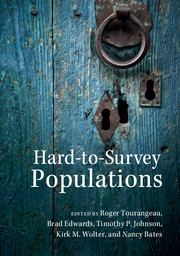Book contents
- Frontmatter
- Dedication
- Contents
- List of figures
- List of tables
- List of boxes
- List of contributors
- Preface
- Part I Introduction
- 1 Defining hard-to-survey populations
- 2 Hard-to-survey populations in comparative perspective
- 3 Measuring undercounts for hard-to-survey groups
- 4 Counting and estimating hard-to-survey populations in the 2011 Census
- 5 A review of quality issues associated with studying hard-to-survey populations
- Part II Conducting surveys in difficult settings
- Part III Conducting surveys with special populations
- Part IV Sampling strategies for the hard to survey
- Part V Data collection strategies for the hard to survey
- Index
- References
4 - Counting and estimating hard-to-survey populations in the 2011 Census
Published online by Cambridge University Press: 05 September 2014
- Frontmatter
- Dedication
- Contents
- List of figures
- List of tables
- List of boxes
- List of contributors
- Preface
- Part I Introduction
- 1 Defining hard-to-survey populations
- 2 Hard-to-survey populations in comparative perspective
- 3 Measuring undercounts for hard-to-survey groups
- 4 Counting and estimating hard-to-survey populations in the 2011 Census
- 5 A review of quality issues associated with studying hard-to-survey populations
- Part II Conducting surveys in difficult settings
- Part III Conducting surveys with special populations
- Part IV Sampling strategies for the hard to survey
- Part V Data collection strategies for the hard to survey
- Index
- References
Summary
Introduction
The census provides a once-in-a decade opportunity to get an accurate, comprehensive, and consistent picture of the population of the United Kingdom. Every effort is made to ensure everyone is counted. The field operation includes many different methods for attempting to count everyone within its overall strategy, and this can include targeting populations that are known to be hard to count. However, no census is perfect and some people are missed, particularly those from hard-to-count groups. These are not uniformly distributed across geography or important subgroups of the population, such as age and sex groups.
A key output from the census is local authority population estimates by age and sex. Local authorities are the 348 local government areas that vary in size from 5,000 to 1 million people. It is important that these census outputs are fit for the purposes they will be put to – for example, resource allocation where hard-to-count minority groups can be those that attract higher levels of funding. To address the likely census nonresponse, a survey-based approach is used to estimate the population that is missed, and the results are used to adjust the census dataset to include representation for that nonresponse. This approach was used successfully in the 2001 Census.
- Type
- Chapter
- Information
- Hard-to-Survey Populations , pp. 58 - 81Publisher: Cambridge University PressPrint publication year: 2014
References
- 5
- Cited by

